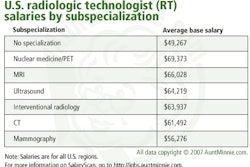Radiology practices that want to initiate exclusive provider agreements (EPAs) with hospitals should be careful what they wish for, attorney W. Kenneth Davis Jr. told attendees of the 2007 Radiology Business Managers Association (RBMA) meeting in St. Louis. Davis is a healthcare attorney and partner of the Chicago law firm of Katten Muchin Rosenman.
EPAs provide a level of predictable revenue generating security and may lock out competing practices. However, based on the recent experiences of his clients, Davis cautioned that they have the potential to be a greater liability than an asset.
An EPA guarantees that the members of a radiology group have sole and exclusive right to provide professional interpretation of diagnostic imaging procedures. The agreement formally defines the responsibilities of radiologists in detail and can eliminate ambiguities. Negotiation of an EPA provides an opportunity for a radiology group to resolve past problems, and to negotiate payment for services provided that have not been previously compensated by a hospital.
According to Davis, how beneficial an EPA will be for the radiologists in the group depends upon the leverage that the practice has over the hospital. Prior to initiating discussions with a hospital, it is important for the radiology group to realistically evaluate how valuable its radiologists are to the hospital, whether the hospital can replace the radiology group with individual radiologists or another practice, and how viable it is for the hospital to do so.
What is the EPA intended to accomplish? What is the likelihood of achieving these goals? How much risk is a practice willing to take during the negotiation process? Davis emphasized that "radiology groups that do not have an EPA should think twice before entering into one."
Based on recent professional experiences with clients, hospital EPAs are increasingly including a "clean sweep" clause, which enables a hospital to terminate hospital staff membership for every radiologist in the group without due process rights. Hospital EPAs are also specifying far more detailed and burdensome limitations on radiology performance requirements, which can place limitations on utilizing locum tenens.
Even more onerous conditions being incorporated into EPAs, Davis said.
"A hospital may seek to make each of the radiologists personally liable for certain provisions of the agreement, if not the entire agreement. This puts individual radiologists at risk," he said. Nine out of 10 groups that have EPAs in place today are in material breach of the agreement, according to Davis.
If the radiology group is providing a director for the hospital's diagnostic imaging department, it is not unusual to have five to eight pages of the agreement specifying this individual's responsibilities. Davis considers this appropriate. "However, you don't want to allow this obligation to become a new source of recovery for the hospital when something goes wrong or when the department is poorly run," he cautioned.
The radiology group should have the authority to select the director, but it is not unreasonable for a hospital to mandate that it can refuse a candidate. Davis contends that "if a hospital is paying a lot for an individual serving in a meaningful hospital administrative role, it should have the right to reject a person they do not want."
Davis recommends that it is imperative that every diagnostic procedure covered in the agreement be specified by CPT code. The document also needs to include a process for adding procedures from modalities acquired after the EPA has been initiated, or for adding procedures based on new uses of existing modalities.
Exceptions should be narrow in scope and very clearly defined. Rather than stating that cardiologists can read cardiac imaging procedures, the procedures that cardiologists are allowed to read should also be specified by CPT code.
"Giving broad carve-outs can chip away at your exclusivity," Davis cautioned.
Davis and his colleagues are increasingly seeing two onerous trends in hospital-written EPAs. The hospital may demand the right to negotiate on behalf of the radiologists when negotiating payor contracts and the right to set professional component fees. Radiologists should reject this condition, as they should do their own contract negotiations and set their own fees.
The process of modifying exclusivity may ultimately be controlled by the hospital's CEO. "Due process may be exercised, but the decision will ultimately be made by the hospital." Why have an EPA at all, Davis mused.
If a hospital is a 501c3 tax-exempt hospital, it is going to be very concerned about private use and private benefit. Theoretically, when a physician practice enters into an EPA, the IRS may interpret this as a management agreement.
"What this can mean is if you have been using the diagnostic workstations in a hospital's reading room to interpret procedures performed at nonhospital-owned facilities, you may be charged fair market value for this private benefit," Davis said. "The cost of benefits catches many radiology groups by surprise, especially if you are asked to fork over $150,000 for the rent you should have paid for the last three years."
If a group has a good working relationship with a hospital without an EPA, it may be wise to leave well enough alone.
By Cynthia Keen
AuntMinnie.com staff writer
July 2, 2007
Related Reading
Equipment maintenance insurance as a strategic financial tool for imaging centers, June 8, 2007
Copyright © 2007 AuntMinnie.com



















